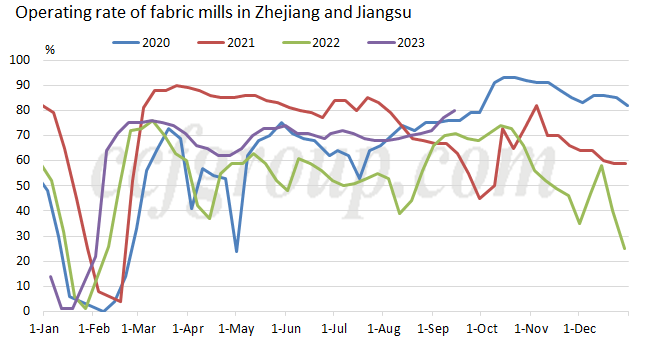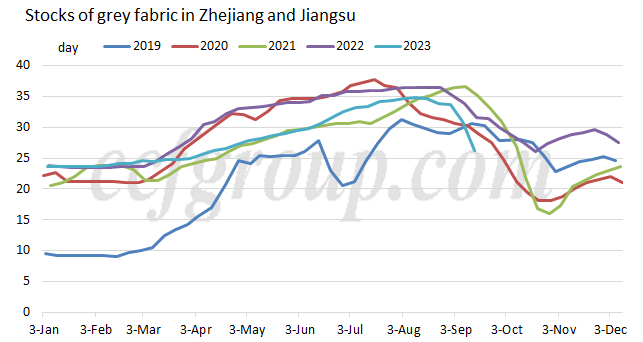Polyester filament market welcomes "carnival" again amid surging oil and peak-season demand
Price of WTI crude oil futures hiked to above $90/bbl again recently since Nov 2022. In addition, the launch of PX futures on Sep 15 also pushed up the price of polyester feedstock. In terms of PX industrial pattern, the startup of new PX projects has been suspended in 2023. With tighter construction policy of refining project, the new PX capacity is estimated to be limited in the future. Only Yulong petrochemical has 3 million tons/year of new capacity under plan now. However, many new PTA units with above 1 million tons/year of capacity are waiting for the startup, including 2.5 million tons/year from Yisheng Hainan, 1.5 million tons/year from FCFC Ningbo, 3 million tons/year from Sinopec Yizheng, 3.2 million tons/year from Sanfame and 2.5 million tons/year from Honggang Petrochemical etc. Meanwhile, the old unit Hanbang is likely to further restart operation. Supply of PX may be tighter in China. Coupled with low operating rate of PX units outside China in recent years, supply crunch of PX market is estimated to remain. Therefore, many large institutes expect PX price to rise after PX future being launched.
Polyester downstream market improved recently. The run rate and orders of downstream plants apparently rose. Stocks of grey fabrics accelerated falling. Domestic orders were good while export orders were mediocre. Some even reflected that the foreign trade was very poor. Sales of grey fabrics were good in Haining and Wujiang and the inventory reduced to low level. The business of warp-knitted rabbit plush fabrics was hot in Changshu, that of milk velvet was moderate and that of flannel improved than before, with falling inventory. Sales of water-jet brushed fabric increased in Changxing and the stocks descended. Sales of some circular knitted terry fabrics, double-faced dralon fabrics and single-faced milk yarn were good in Xiaoshan and Shaoxing. Based on various indicators, downstream market has entered peak season in advance and better than market expectation. Except for growing seasonal demand, it was also related with rising feedstock price and the constrained of logistics on the Asian Games, as well as the production limit of some polyester companies.
The operating rate of DTY plants has increased to 84% in Zhejiang and Jiangsu, that of fabric mills ascended to 80% in Zhejiang and Jiangsu and that of printing and dyeing plants rose to 83% in Zhejiang and Jiangsu. The run rate of downstream plants has hit yearly high, higher than the same period of past years.

Stocks of grey fabrics also accelerated falling recently, which have reduced by 25% from 35 days in mid-Aug to 26 days now. After stocks of grey fabrics fell, price of grey fabrics also followed the uptrend of raw materials.

With strong crude oil and PX prices, coupled with peak season on downstream market in Sep, stocks of PFY reduced further. The inventory of POY and FDY has decreased to yearly low and price also sped up to increase. PFY price was stable or only slightly advanced by 50yuan/mt before but it ascended by 1000yuan/mt now. PFY market seemed to see "carnival" again.
In long run, downstream business seemed to improve while there may be two hidden troubles later. Firstly, current downstream business is mostly supported by domestic sales, while the export business is mediocre. Some even reflect that export orders are poor now. Once domestic sales weaken, downstream business is likely to lack support. Secondly, current price of grey fabrics fails to chase up that of raw materials. Fabric mills witness good sales but meager profit, and many orders are concluded in debt basis. If feedstock market or demand turns weaker later, the production activity of downstream plants is supposed to be obviously dragged down. As for domestic demand, it is suggested to concern the status near mid-Oct. Demand is supposed to weaken by convention by that time in previous years. Export orders may be hard to improve this year. As demand weakens in Europe and US and the destocking cycle outside China is slower than anticipated, domestic and export orders are unlikely to grow much within 2023. It is advised to observe the orders of 2024 until Dec 2023 and Jan 2024.
- Top keywords
- Cotton Price
- Cotton Futures Price
- Cotton Futures
- CZCE
- PTA Futures Price
- Chemical Fiber
- Polyester Prices
- Wool price
- PTA Futures
- Shengze Silk
- China
- Yarn Price
- price
- China Textile City
- Fibre Price
- Benzene Price
- Cotton
- Index
- Cotton Index
- PTA
- fabric price
- NYMEX
- Top 10
- textile industry
- Spot Cotton
- Cotton Yarn
- Polyester Price
- Futures
- PTA Price
- cotton yarn price

